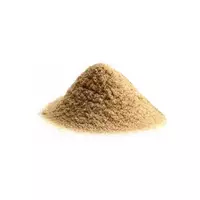Barley flour

Even in childhood, reading Russian folk tales, we are the first to get acquainted with barley flour. Remember the famous words of the fabulous character "I left my grandmother, I left my grandfather. " Kolobok is not just a fictional fairy-tale hero, it is a real dish of Russian folk cuisine, which was baked just from barley flour.
Barley is quite famous and ancient cereal culture. The Bible mentions barley that was grown in the harsh climates of Palestine. Unlike wheat, which is considered a whimsical plant due to special requirements for watering and soil, barley can grow even in drought.
Barley flour was used to make rough "poor" bread, because it was the poor who could not afford white bread, because wheat was worth its weight in gold, grew and processed barley. Flour called Tolokno has long been made from barley or oats. Grains of cereals were steamed, dried, fried and peeled, and then pushed in a special stupa, hence the name of the flour.
Barley flour looks rougher and contains a decent amount of bran, the color of the flour is gray. Barley flour is considered indispensable when baking tortillas and loaves. The chemical composition of barley flour resembles rye flour, but there is also its own specificity.
Barley bread acquires its special tart taste due to its high fiber content. As a result of recent research, scientists have compiled a kind of rating of products that are most useful for the human body.
Barley was in second place on this list, the cereal lost the championship only to the Kiwis. It turned out that the use of foods containing barley significantly lowers the level of "bad" or "harmful" cholesterol.
Currently, barley flour is not used in its pure form when baking bread. Usually, barley flour is mixed with wheat flour to achieve the best adhesive qualities of dough. The appearance and taste of baking directly depend on the quality of barley flour.
If you want to bake the right barley kolobok, then be sure to pay attention to the flour. Barley flour should be gray-white, crumbly consistency, swell well. Flour has no taste or smell. If you taste barley flour and it is mustard or sour - this suggests that the flour has deteriorated and should not make dough from it.
If everything is the opposite and barley flour tastes sweet, then such flour was made from lying sprouted grain. From such flour, sensible baking will not work. The dough will not swell well, and the finished pastry will settle. In order not to throw away spoiled flour and not spend money on buying a new one, follow the cunning storage rules. Barley flour should be stored in a tightly closed container, in a dry and dark place.
barley flour 284 kCal
Energy value of barley flour (Ratio of proteins, fats, carbohydrates - ju):
Proteins: 10 g (~ 40 kCal)
Fats: 1.6 g (~ 14 kCal)
Carbohydrates: 56.1 g (~ 224 kCal)
Energy ratio (b | y): 14% | 5% | 79%
 Español
Español Français
Français Português
Português Русский
Русский 简体中文
简体中文 繁體中文
繁體中文 日本語
日本語 한국어
한국어 العربية
العربية Türkçe
Türkçe Қазақ
Қазақ Deutsch
Deutsch Italiano
Italiano Українська
Українська
